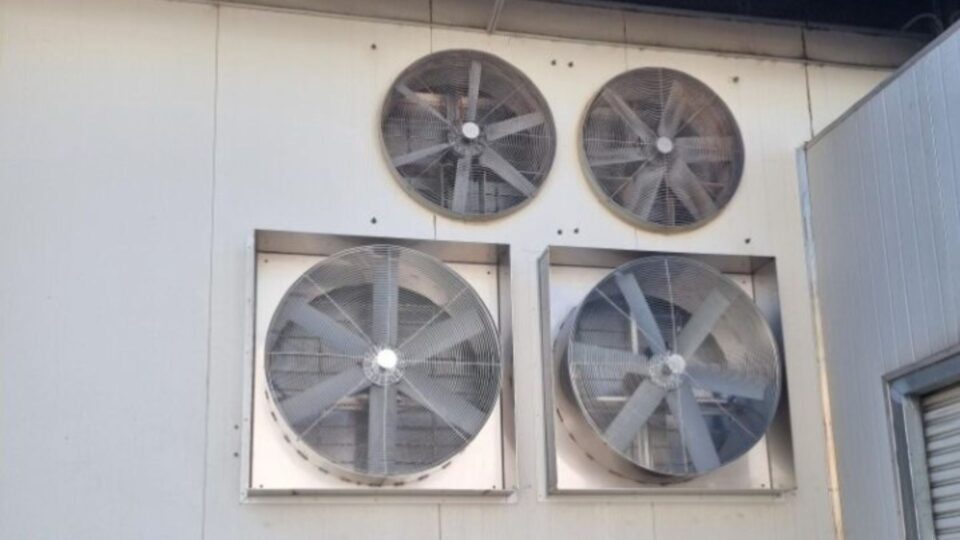The CISRO estimates that the cost of poor indoor air quality in Australia may be as high as $12 billion yearly due to the health issues it causes, leading to lost production. Volatile Organic Compounds (VOCs) can come from paint, carpets, furnishings office equipment and other building materials. Side wall exhaust fans are a popular solution for managing indoor air quality and temperature.
What are the top applications for side wall exhaust fans in Australia?
Read on as we explore and discuss side wall exhaust fans – their uses, advantages, disadvantages, and more.
What is a side wall exhaust fan?
A side wall exhaust fan is a popular ventilation and extraction solution used across various industries. Here are some of the main features of side wall exhaust fans:
- Wall-mounted installation – side wall exhaust fans are designed to mount on the side wall of a building, providing more space economy and convenience.
- High airflow capacity – a side wall exhaust fan can move significant volumes of air, making it an ideal solution for large-scale facilities. This airflow helps to remove stale air and pollutants.
- Durable construction – a side wall exhaust fan can withstand harsh conditions and corrosive materials, as it is typically made using robust materials like galvanized steel or aluminium.
- Variable speed control – you can control the fan speed to ensure your ventilation requirements are met while regulating airflow and exchange rate.
- Louvres and dampers – most side wall exhaust fans come with louvres and dampers which prevent backflow and control the direction of air movement.

Applications for side wall exhaust fans
Now that you know what a side wall exhaust fan is, let’s explore the different applications for side wall fans.
Agriculture
In the agricultural industry, side wall fans help to control the temperature and humidity levels to prevent illnesses in barns, poultry houses, and animal storage facilities. They also remove odours, dust, and airborne contaminants to assist in greenhouse crop growth and create more breathable air.
Construction
During construction activities, a significant amount of dust, fumes, and pollutants are created. Side wall fans help to reduce the number of contaminants in the air to keep workers safe and prevent respiratory issues. They can also help to reduce humidity and condensation during winter, protecting the structural integrity of properties from mould and dampness.
Food processing
Commercial kitchens, bakeries, and food processing facilities generate cooking odours, heat, and steam. Side wall fans help to reduce odours and create a more pleasant working environment.
Laundry
Laundry facilities produce heat and steam, and stale air can cause fresh laundry to smell. Side wall fans help to keep the air fresh in a commercial laundry facility while facilitating the drying process by reducing humidity.
Manufacturing
Manufacturing processes can produce steam, smoke, fumes, and other airborne particulates. Side wall fans help to provide more clean air during welding or grinding operations by removing contaminants. They also regulate temperature and humidity to ensure product integrity and promote comfort for workers.
Mining and metals
Mining produces airborne contaminants such as sulphur dioxide, which can compromise worker safety due to the risk of explosions or combustion. Using side wall fans can ensure industry compliance while ensuring worker safety and comfort.
Smelters and refineries
Volatile compounds are generated during smelting and refining processes. Side wall fans help to minimise air pollution while providing more comfort for employees by controlling temperature and removing excess heat.
Warehouses
Warehouses can overheat during warmer months, leading to heat stroke and other complications for worker health. Investing in side wall fans can ensure safe and comfortable working conditions with temperature control and clean air.
Advantages and disadvantages of side wall exhaust fans
You should make certain considerations before choosing side wall exhaust fans for your industrial facility. Here are the side wall exhaust fan advantages and disadvantages.
Advantages
What do you stand to gain from implementing side wall exhaust fans?
Less maintenance (than belt drive fans)
Side wall fans require less manual intervention than belt drive fans. With a belt drive fan, you must ensure the belt is inspected and replaced regularly and provide regular lubrication. The simplified design of side wall exhaust fans provides more convenience for maintenance than a belt drive axial fan.
Insect and waterproof
Side wall fans protect from insects and water that might enter the fan and ventilation system. A protective grille or screen ensures your facility stays free from insects and water.
Disadvantages
Here are the drawbacks to consider for side wall exhaust fans.
Slightly less efficient (than ceiling fans)
Side wall fans can only move air for a short distance compared to ceiling fans. A ceiling fan provides an upwards airflow from overhead to ensure maximum airflow. The obstructions and airflow restrictions make side wall fans less efficient.
Choose Fanquip for high-quality side wall exhaust fan solutions
Side wall exhaust fans are a staple feature for ventilation in a wide range of industries. Though they may be less efficient than ceiling fans, they provide a low-maintenance, high-volume air circulation solution.
If you’re considering using side wall exhaust fans for your facility, contact our team at Fanquip. We have experts on hand to help you understand the ventilation regulations for your industry sector.
